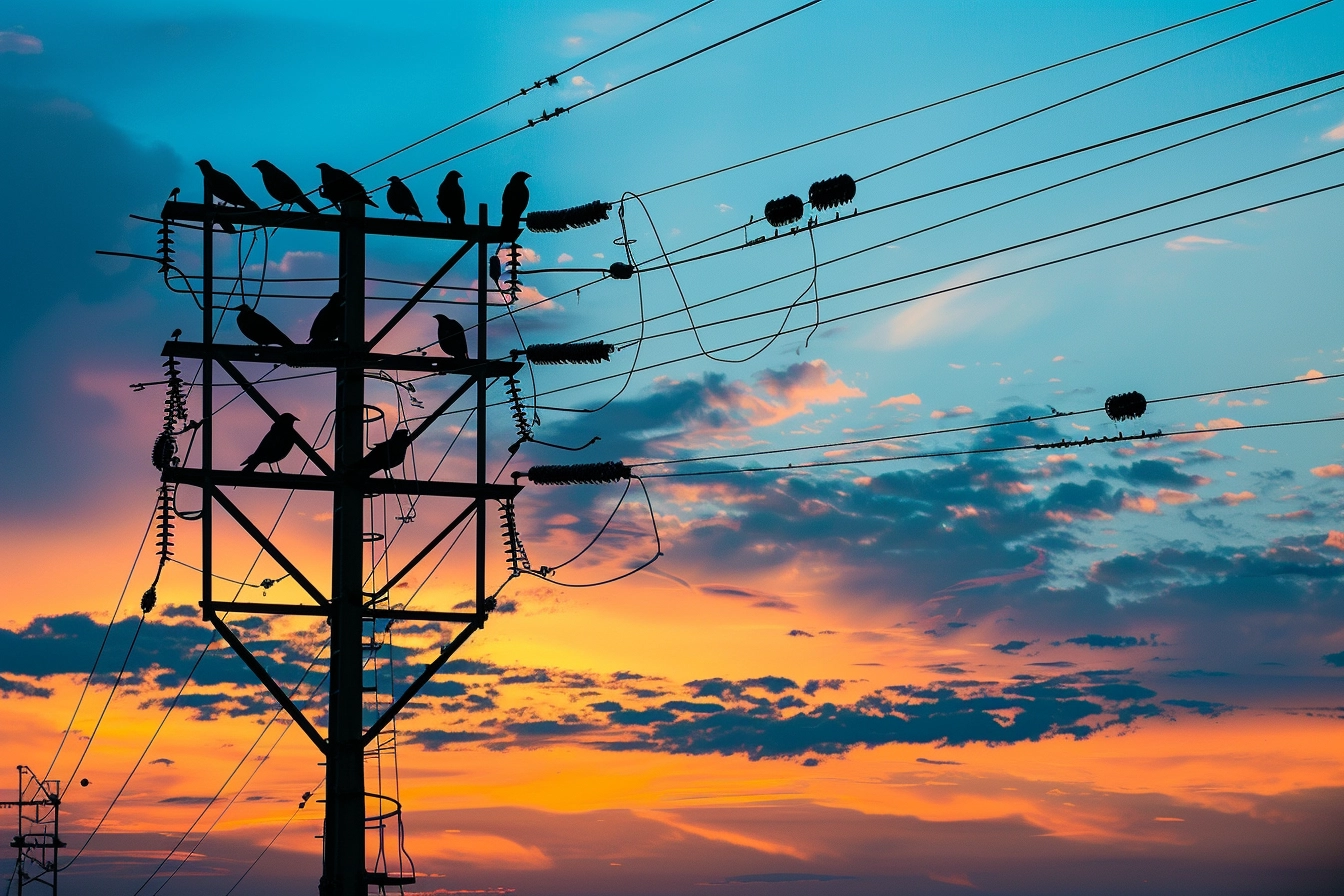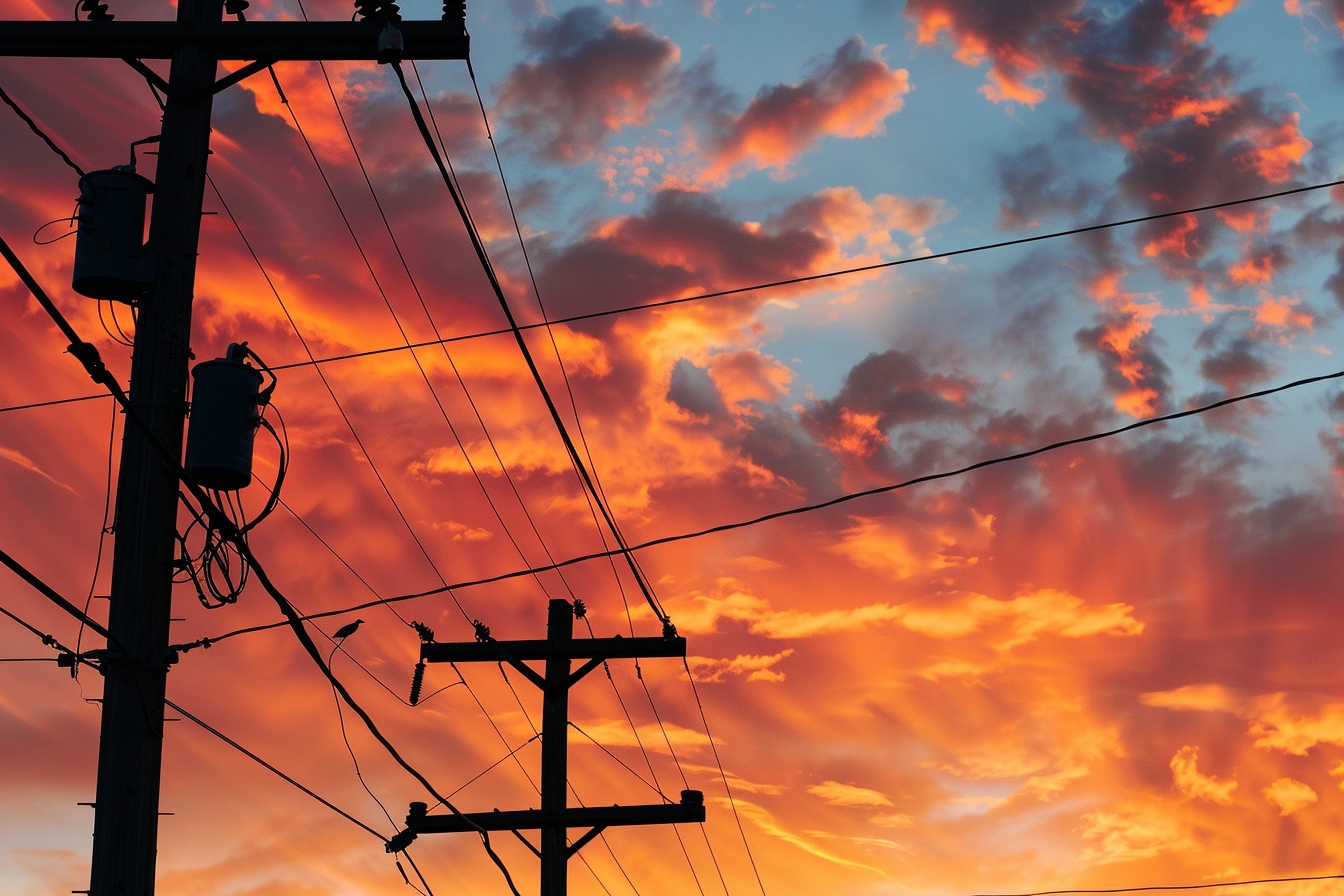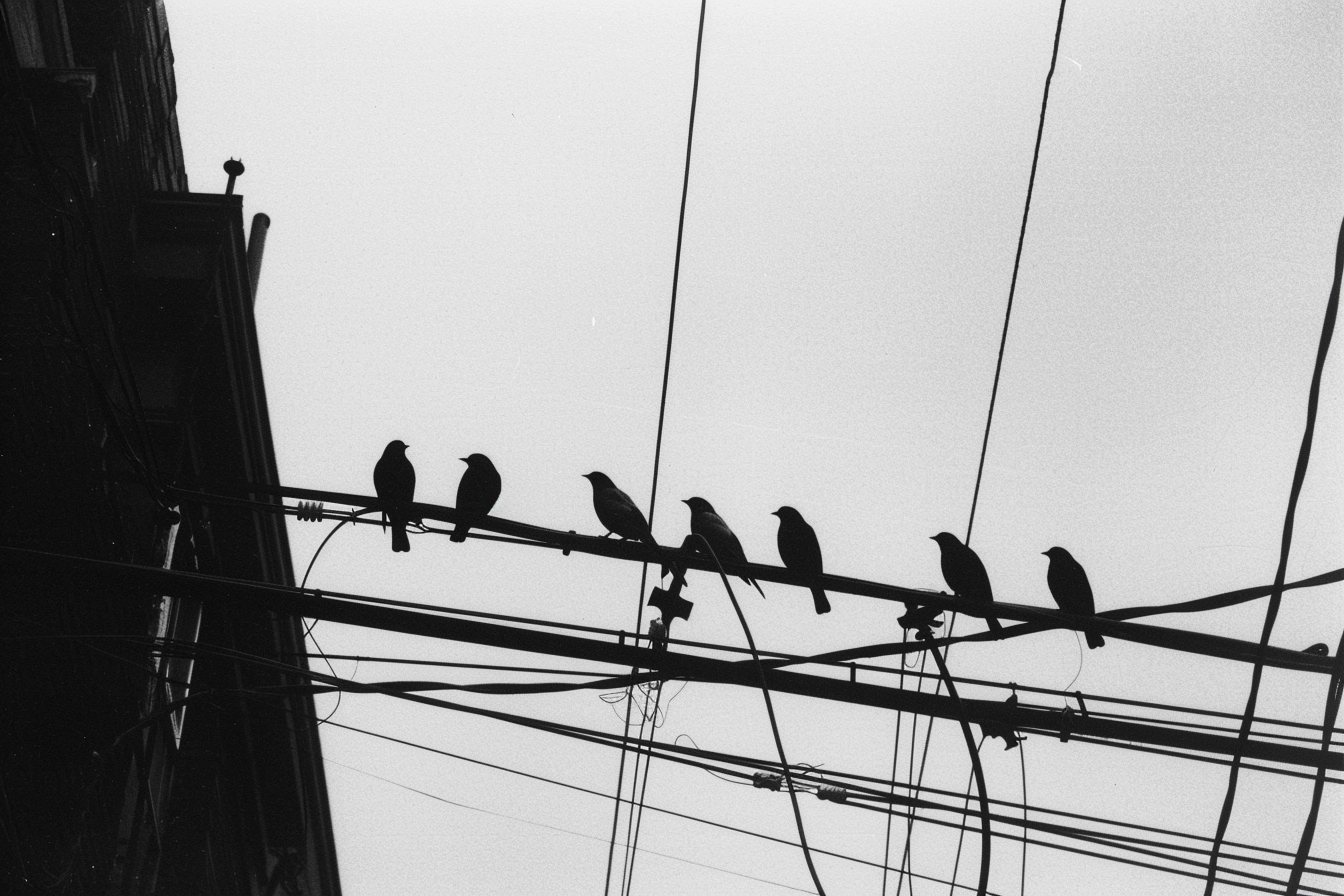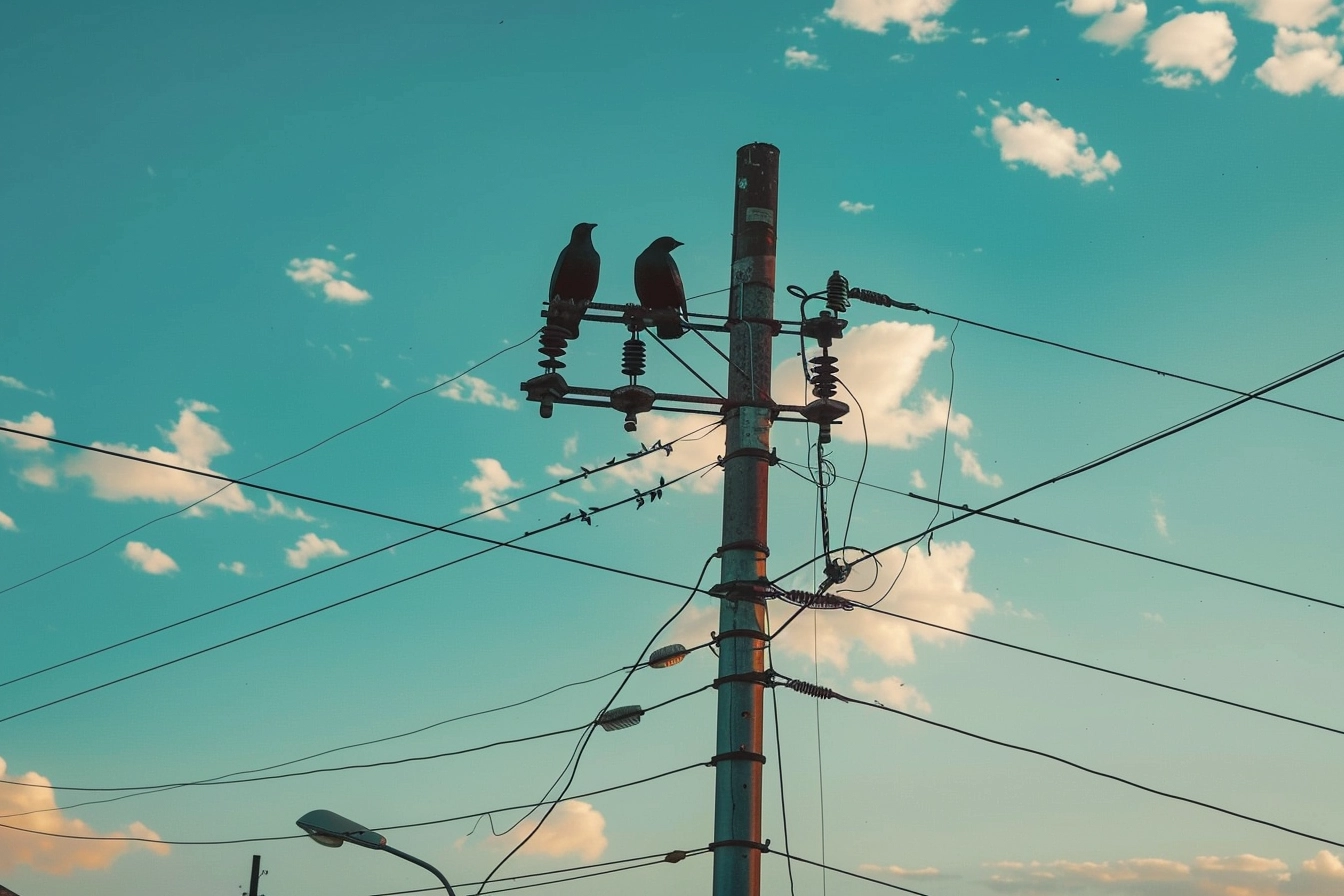Observing birds as they land gracefully on high-voltage power lines is a common sight that often raises the question of their safety amidst such dangerous voltages.
The simple act of perching there, seemingly unfazed by the potential for electrocution, is a wonder of nature.
Birds can safely sit on electrical wires because they do not create a path for electricity to travel to the ground, which means they do not complete an electrical circuit.
Power lines carry electricity that flows in a closed loop, needing a conduit to move from high to low voltage areas; usually, this is through the ground or a grounding path.
When a bird lands on a single wire, it remains at the same electrical potential as the wire itself, preventing the current from flowing through its body. This is why birds don’t get electrocuted.
Ensuring the protection of these avian creatures and the maintenance workers who repair lines is of paramount importance and dictates specific practices and designs in the construction and upkeep of electrical infrastructure.

Key Takeaways
- Birds can safely land on power lines because they do not create a ground pathway for electricity.
- The electrical potential of a single wire is uniform, enabling birds to perch without completing an electrical circuit.
- Protective measures are crucial for both wildlife and human safety when interacting with high-voltage power lines.
Understanding Electricity and Power Lines
Electricity is a fundamental aspect of modern society, flowing through an extensive network of power lines.
Electric Current and Circuitry
Electric current is the flow of electric charge, which moves through a conductor, such as a copper wire, when there’s a voltage, or electric potential difference, across it.
This flow typically occurs in a closed loop known as a circuit.
Electrical circuits must have a complete path without any breaks for electricity to flow continuously.
Electrical Potential and Grounding
Voltage describes the difference in electrical potential between two points in a circuit. For electricity to flow, there must be a difference in potential, often achieved by connecting circuits to ground, a grounded object serving as a reference point with zero voltage.
Grounding is a safety mechanism that provides a path for electric current to dissipate in the event of a fault.
Safety Mechanisms in Power Line Design
Power line design incorporates multiple safety mechanisms to prevent electrical shock and ensure system resilience.
Insulation and protective covers on wires and equipment protect against unintended current flow.
Additionally, electrical components are carefully engineered to handle specific voltages and currents, preventing overloads that could lead to outages or hazards.
Conduction and Insulation Materials
Conductors, like metal wires, allow the flow of electric charge with minimal resistance, whereas insulators resist current flow.
Conduction materials used in power lines often include copper or aluminum, which offer a balance between conductivity and durability.
Insulation is crucial to prevent the energy from ‘leaking’ to undesired paths, such as via birds landing on wires or the wooden poles that often support them.
Transmission and Distribution Infrastructure
The network that carries electricity from power stations to your home is known as the transmission and distribution infrastructure.
High-voltage power lines transmit electricity over long distances efficiently, reducing the energy lost as heat due to resistance in the wires.
As the electricity nears its destination, the voltage is stepped down through substations for safe distribution to consumers.

Birds and Power Lines
Exploring how birds interact with power lines involves understanding the mechanics of avian flight, the reasons why electricity generally doesn’t harm them when they perch on wires, and the significance of these lines for various bird species.
You’ll discover why the sight of birds on power lines is common and not usually a cause for concern.
Avian Flight Mechanics
Birds, including species like starlings and larger birds, boast highly specialized flight mechanics.
Your observation of flocks of birds effortlessly gliding and then perching on wires reflects their adept control during landing.
Large birds, such as hawks, utilize a wide wingspan and tail dynamics to reduce speed and make a controlled approach, allowing for a gentle touchdown on wires, while smaller species like starlings may arrive in large flocks and use rapid wing beats followed by extended wings to perch smoothly.
Birds Interacting with Electricity
The phenomenon of birds unharmed while resting on power lines can seem puzzling at first. It’s essential to understand electricity takes the path of least resistance; when a bird lands on a single wire, it doesn’t create a new path for electricity to travel, thus avoiding electrocution.
Your awareness of this concept clarifies why incidents of birds receiving an electric shock are rare and usually involve contact with multiple wires or grounded objects.
The Phenomenon of Perching on Wires
Power lines offer birds a number of conveniences, such as an elevated view to spot prey and a safe zone from ground predators.
Often, you’ll see that birds on power lines are roosting, which is a form of rest.
These lines mimic natural perching spots like tree branches, making them attractive to a wide range of bird species.
It’s a common electronic-age adaptation that’s fascinating to observe, as it contrasts natural instincts with man-made structures.
The Science Behind Bird Safety on Power Lines
Electricity is a phenomenon that behaves according to specific physical laws which both birds and humans are subjected to; however, birds have a unique interaction with electric fields due to their body structure. Here’s how birds can safely land on power lines without harm.
Why Birds Don’t Get Shocked
Birds can perch on live electrical wires without being shocked because they don’t create a voltage difference.
When you touch a wire, electrons need a place to go. Birds’ bodies don’t fulfill this condition if they touch a single wire.
Their two feet are typically at the same electrical potential, so the electrons have no reason to flow through their body—current needs a difference in electric potential to move, just as water flows from high to low points.
Differences Between Birds and Humans
Your safety is a different story.
Humans are often grounded and conduct electricity well, unlike birds.
You become a conductor the moment your body creates a circuit with the ground.
Imagine a live electrical wire dropping to the ground; it sparks and crackles because the current finds a path through the conductive materials it touches.
Touching a wire while you’re grounded results in an electric current flowing through you, likely leading to being shocked.
Understanding Electrical Conductance in Birds
Birds are surrounded by air, which is an insulator.
When they land on a single wire, they are not touching the ground or another wire with different voltage, so they aren’t closing a circuit for the current to flow through.
Their bodies don’t act as a bridge between different electrical potentials.
However, if a bird simultaneously touches two wires with different voltages, it completes the electrical circuit, allowing electricity to flow through, which can be fatal.
Hence, while small birds are generally safe, larger birds risk touching adjacent wires due to their wingspan.

Implications for Power Line Maintenance
When birds land on power lines, your considerations regarding maintenance extend beyond ensuring power flow; they include safeguarding both the avian visitors and the infrastructure itself. Specific strategies and mechanisms are key in this balancing act.
Maintaining Safety for Wildlife and Equipment
Safety for wildlife and equipment emerges as a core priority in power line maintenance.
By implementing spacing strategies that deter perching and by installing devices that minimize the risk of collision and electric shock, you protect both birds and the integrity of the equipment.
Not only does this approach promote an unobstructed operation of power lines, but it also upholds your commitment to environmental stewardship.
Common Hazards and Preventative Measures
Encountering hazards such as nesting and droppings can lead to equipment failures.
Preventative measures, such as bird deterrents and insulator covers, are essential tools in your maintenance kit.
- Bird deterrents: Ensure consistent application across power lines to reduce incidents.
- Insulator covers: Routinely check and replace these to maintain their effectiveness.
Operation and Monitoring Systems
Your operation and monitoring systems form the nerve center for power line maintenance.
Sophisticated report mechanisms and sensors can alert you to potential disruptions in real-time, allowing for swift action.
Regularly updating these systems ensures that you stay ahead of both routine maintenance and unforeseen challenges in infrastructure management.
- Monitoring systems: Deploy these along key points to detect and address issues promptly.
- Report mechanisms: Keep these streamlined to facilitate quick transmission of information.
Wildlife Interaction with Electrical Components
When discussing the interaction of wildlife with electrical components, the emphasis is on the behavior of birds around power lines, the risks they face, and the conservation efforts in place for their protection.
Power lines can influence birds’ behavior, present a risk of electrocution, and thus necessitate specific protective measures.
Effects of Power Lines on Bird Behavior
Birds may use power lines as perching sites, enabling a vantage point for spotting prey and other birds.
Flocks often gather on these elevated electrical conductors, drawn to the area for the extra warmth they provide.
When roosting on power lines, starlings and other birds can survey surrounding areas for food and potential threats.
Incidental Contact and Risks for Birds
The inherent danger of power lines comes into play when birds make incidental contact with an electrical conductor and another conductive element, leading to electrocution.
This can occur if birds simultaneously touch two wires or a wire and a grounded structure.
Larger birds, such as eagles, are at greater risk due to their wider wingspans making contact more likely.
Additionally, other animals like squirrels may also face these dangers while traversing power lines.
Protective Measures for Bird Conservation
To ensure safety, utility companies have developed various protective measures.
Installing protective covers over wires and providing adequate insulation can prevent accidental contact.
These safeguarding tactics preserve bird life and maintain electricity supply integrity by preventing outages caused by wildlife contacts.

When you observe birds perched confidently on power lines, it’s clear that their ability to do so is a result of simple physics and anatomical adaptations.
These bird species have evolved to sit on high-voltage lines without harm.
- Electrical potential: Birds’ feet are at the same electrical potential when they sit on a single wire, preventing electric current from passing through their bodies.
- Physical spacing: Power lines are spaced far enough apart to prevent the birds from touching two lines at once, which would create a circuit and result in electrocution.
Remember, while it’s safe for birds to perch on the wires, certain actions, such as touching another wire or grounded structure, can be dangerous.
But generally, birds use these power lines as safe resting places and vantage points to scout for food, without the risk of electrocution.
- For a deeper understanding of the intricacies involved, especially regarding the science behind why birds don’t get electrocuted, you might find it beneficial to further explore how birds can sit on power lines without danger and reasons why they choose to sit there.
